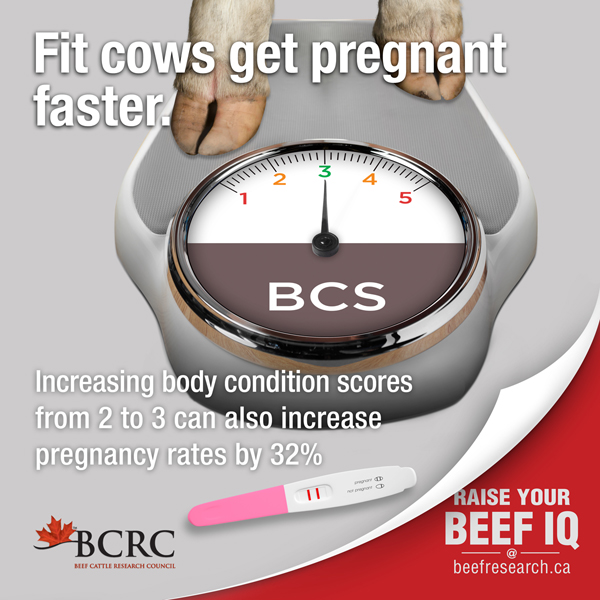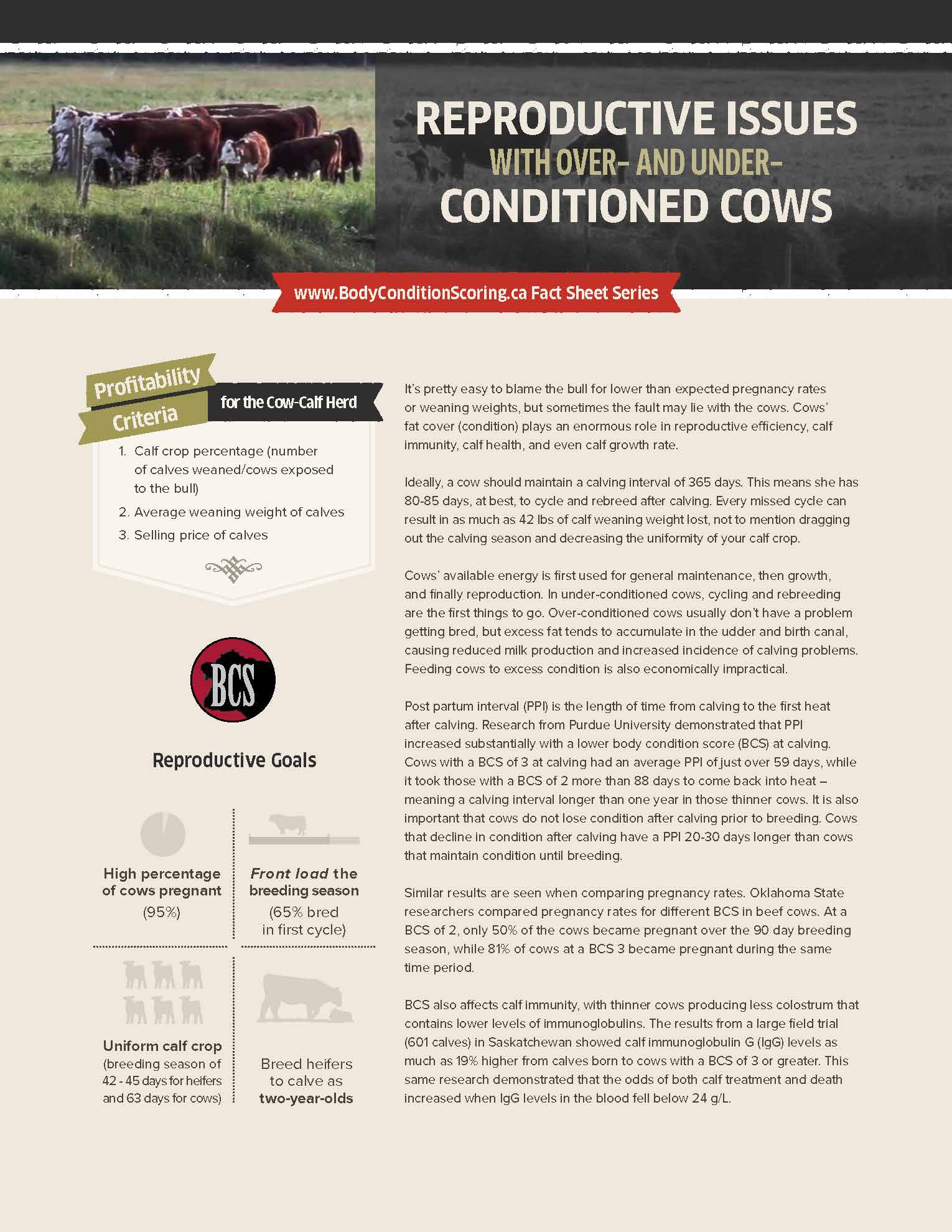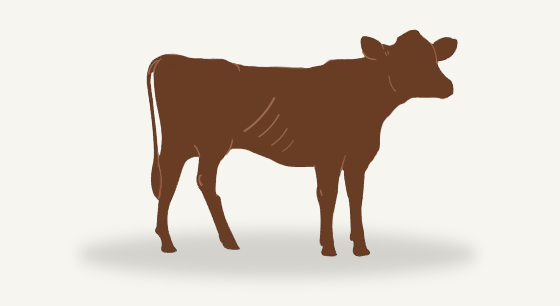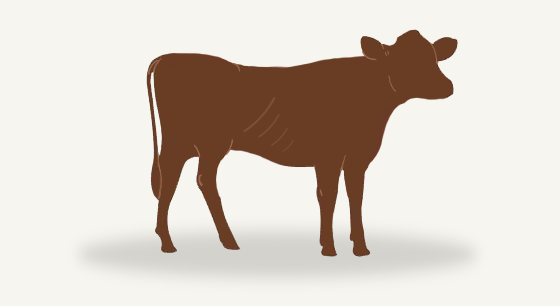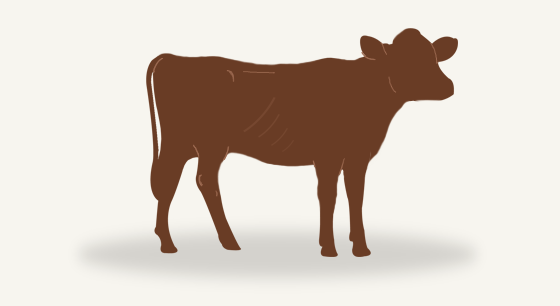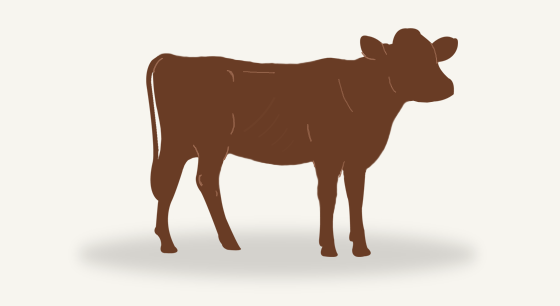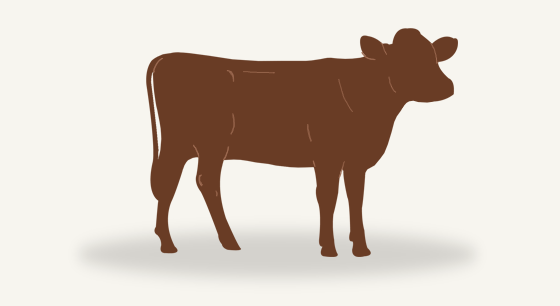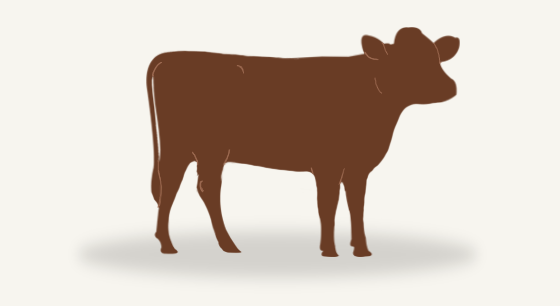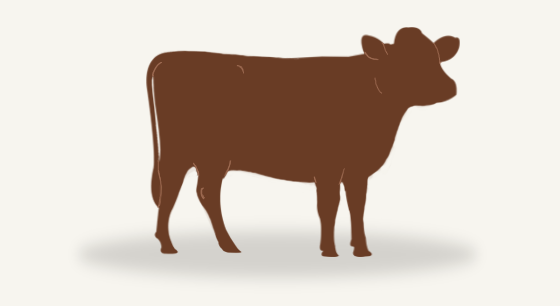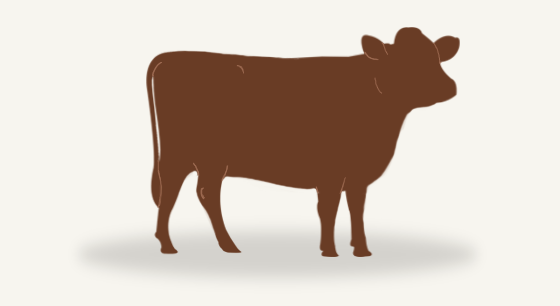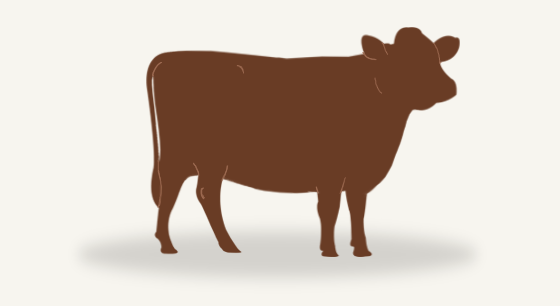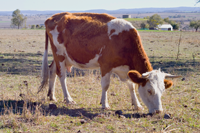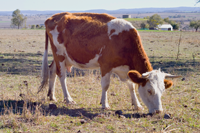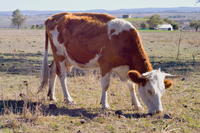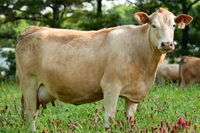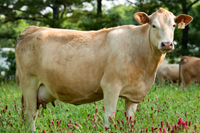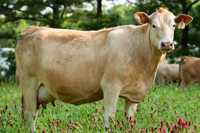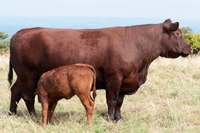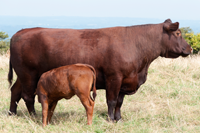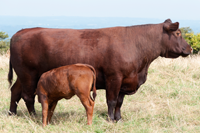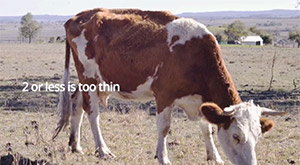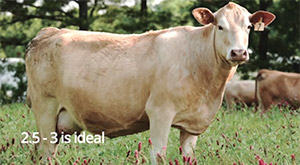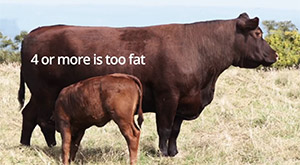Optimum body condition = maximum production
The productivity of beef cows depends largely on the amount of fat they carry. A herd of cows maintained in the right condition with an ideal layer of fat cover will have more (and heavier) calves than a herd of thin or over-fat cows.
On this page
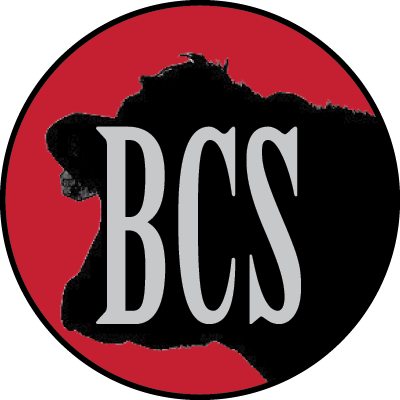
- What is body condition scoring?
- How do I body condition score?
- Video
- Why is measuring body condition worthwhile?
- Interactive Body Condition Scoring Tool
- Feed Cost Calculator
- When do I body condition score?
- What should I do if my animals are underconditioned?
- Considerations
- Downloads / Fact Sheets
- Learn More
- References
What is body condition scoring?
Body condition scoring is a low cost, hands-on method to determine the condition (amount of fat cover) cattle have. This easy hands-on method is much more accurate than just looking at the animals.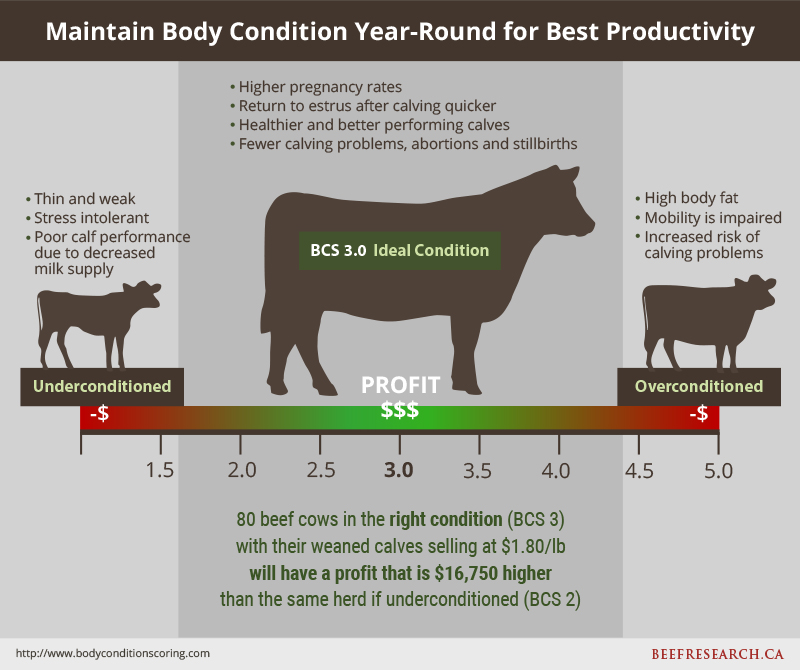
Looks can be deceiving, even to the trained and experienced eye. The shadows that help you see the body’s dips and hollows are harder to see on black cattle. The accuracy of visual evaluation also varies with the season. Prominent rib, hook and pin bones can be masked by long winter hair coats. Thin cows with round bellies full of straw can be mistaken as being in ideal condition when in fact they need improvement.
Research from the University of Guelph reported that even trained visual evaluators had a hard time accurately predicting the body condition score of cows in winter. The correlation between visual scores and ultrasonic backfat measurements was low (r2 = 0.14) in January to March. Cows in later stages of pregnancy may also appear to have more fat cover. A hands-on evaluation of the body condition score will give you a much better sense of your cows’ fat stores.
In Canada, body condition is scored from 1-5, with 1 being extremely thin and 5 being obese. A score of 3.0 is ideal.
How do I body condition score?
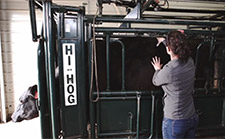 Feel for fat cover with your hands at:
Feel for fat cover with your hands at:
An animal in ideal condition will have a thin layer of fat in these areas, so it will take some pressure to feel the bones.
An underconditioned animal’s bones will be quite prominent and sharp. In an obese animal, you won’t be able to feel any of the individual bones through the thick layer of fat.
See a demonstration in the video below.
Why is measuring body condition worthwhile?
By having an accurate measure of your cows’ body condition, you’ll have a good indicator of how to manage their rations to maximize their productivity, especially reproduction.
Cows with an ideal body condition score (3.0) rebreed up to 30 days sooner than thin cows, which allows more cows to calve in the first 21-day cycle. This can add up to 42 lbs in calf weaning weight since the calves born earlier in the calving season will be heavier at weaning time. Cows in ideal body condition also have pregnancy rates double those of cows in poor condition, have improved milk production, fewer cases of abortion and stillbirth, healthier calves, and have fewer instances of calving problems.
The salvage value of cull cows in good condition is also higher. Very thin cows are more likely to experience negative outcomes during transport or to be condemned at the plant. Thin cows reflect poorly on the producer and the industry. It is important to note that thin cows are not always strictly related to nutrition. Several diseases such as Johne’s disease can be a contributing factor to thin cows.
Slide the bar below to see how body condition affects cows’ productivity and the value of their weaned calves.
Feed Cost Calculator
Scenario: Increase BCS from 2 to 3 in a 1400 lb cow in mid gestation in thermoneutral weather .
Instructions: Use the drop down menu to choose a feeding period. Use the drop down in the “Proportions of Diet” column to approximate the proportion of each feedstuff in the diet (the combined values of the four dropdowns must add to 100%). Manually enter the cost/lb of each desired feedstuff into the “Feedstuff” column. All the rest of the cells will autocalculate.
Disclaimer: This calculator is for demonstration purposes only and may not apply to your cowherd and feeding situation. To get a precise idea of what your cows need, please get your feed tested and then consult ration balancing software (e.g. CowBytes) or a nutritionist.
In this scenario, the extra feed cost to improve condition from BCS 2 to 3 does not offset the extra value of the weaned calf crop but consider:
1. Alternative ways to improve condition at other times of the year:
- It is easier and more economical to add condition in early-mid gestation (summer/early fall) than in mid-late gestation (late fall/winter). Next year, if working to improve condition, consider supplying high quality feed or pasture at an earlier and more economical time of the season.
- Weaning calves from thin cows early will lower those cows’ energy needs.
2. Poor condition is a slippery slope:
- If poor condition is not improved, reproductive momentum will be lost: first the calving season will lengthen, subsequently weaning weights will decrease, and open rates will increase.
- Selling an open thin cull cow will not offset calf revenue from a cow that remains in the herd and calves on time for many years.
- Thin bred cows will continue to lose condition, which could develop into a significant welfare concern if not remedied.
NOTE: the following data is based on the “Number of Cows” and “Sale Price of Weaned Calves” values from the calculator above the Feed Cost Calculator; ie. changing those values will also affect this data.
**In some instances a cow will not be able to physically consume enough of a particular feedstuff to get the nutrients required. For a 1400 lb cow on barley, maximum intake is about 33 lbs/day, for average quality alfalfa grass hay and cereal silage, 29 lbs/day, and good quality cereal straw 27 lbs/day. If any of your feedstuffs in the “Total lbs of feedstuff required/day” column are above those numbers, you need to readjust the proportions of each feedstuff in the diet.
**During periods of cold temperatures, a general rule of thumb is to increase the energy component of the ration by feeding additional grain or pellets at a rate of one lb. per head per day for every -5° C that the temperature is below -20° C at mid-day. For example, if the afternoon air temperature was -35° C, feed an additional three lb. of grain or pellets per cow.
**Some types of extended grazing, such as swath grazing, can increase energy requirements by 18-21%.
**Cows in late gestation or lactation will have 20-45% higher energy and 40-80% higher protein requirements than cows in mid-gestation.
When do I body condition score?
One of the best times to body condition score is during fall processing or pregnancy checking. This will give you time to add condition on thinner cows before winter sets in. Reproductive performance in the spring depends on nutritional planning in the fall.
The more often you body condition score throughout the year, the better you’ll be able to manage their nutrition to keep them at a score of 3.0 year-round.
What should I do if my animals are underconditioned?
If you have animals at a body condition score of 2.0 or lower, you’ll need to manage them differently than you have been in order to add body fat and bring them up to a 3.0.
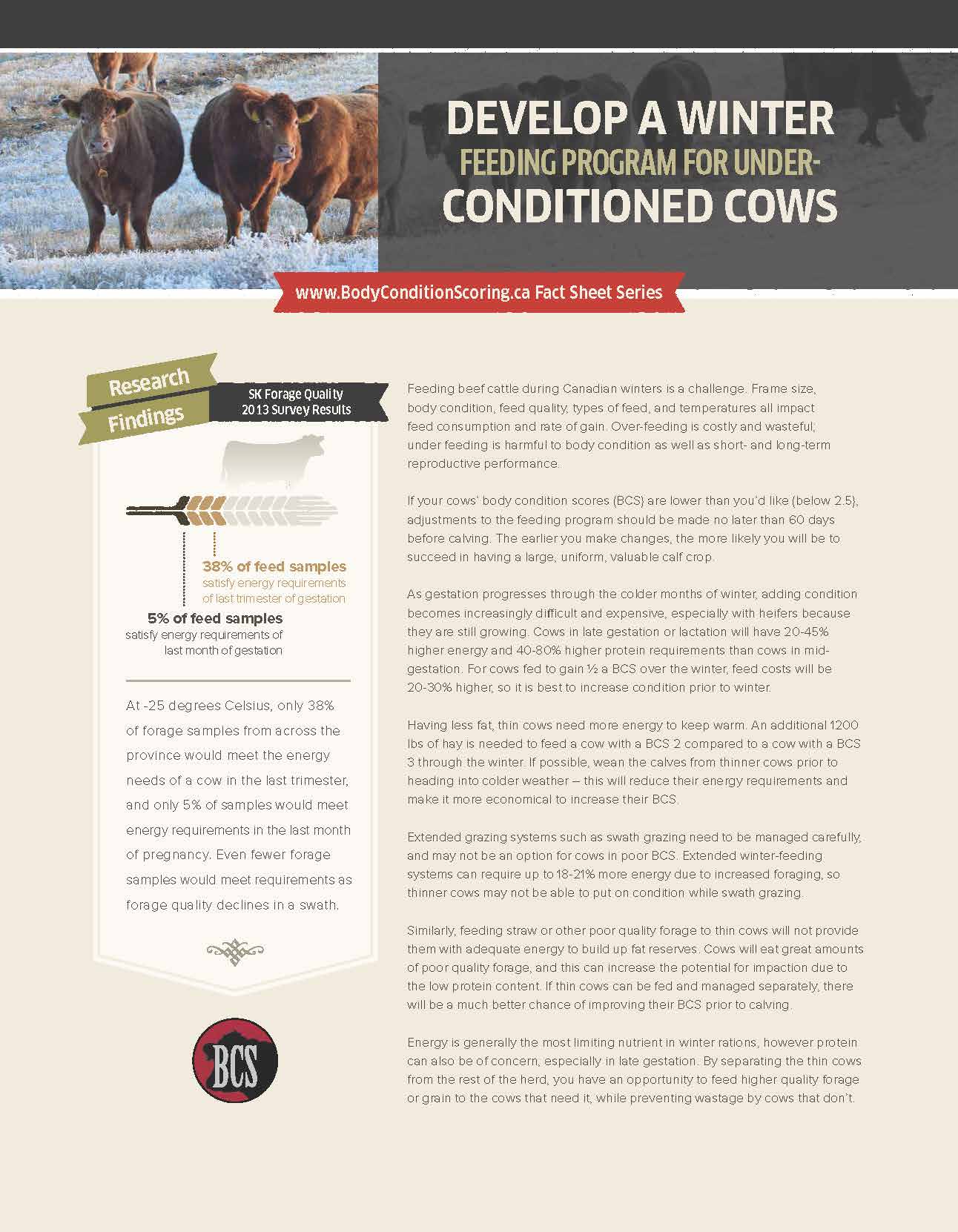 If cows are thin when they come home from pasture in the fall, work to improve their condition right away. Cow maintenance requirements increase substantially (up to 40% more) during the winter and during late gestation.
If cows are thin when they come home from pasture in the fall, work to improve their condition right away. Cow maintenance requirements increase substantially (up to 40% more) during the winter and during late gestation.
A 1400 lb cow will require about 200 lbs of body weight gain to move from a body condition score 2.0 to 3.0. To make this change in 90 days requires 20% more energy than a cow that is maintaining condition; to do it in 60 days requires 30% more energy. It will be 20-30% more expensive to try and increase condition during the winter.
When looking at a group of cows, if a small number of them are thin, that may mean that those few thin animals simply don’t fit a given environment or management system. Larger numbers of thin cows within a group suggest the group doesn’t have enough feed or that their feed is poor quality.
Feed testing is inexpensive and necessary to help ensure that your cows are getting enough nutrition. Judging your forages based on their plant type, colour, leaf content and knowledge of cutting time does not substitute for feed testing. Learn more about the value of feed testing and the nutritional needs of cows and heifers in each trimester at http://www.beefresearch.ca/blog/feed-testing/
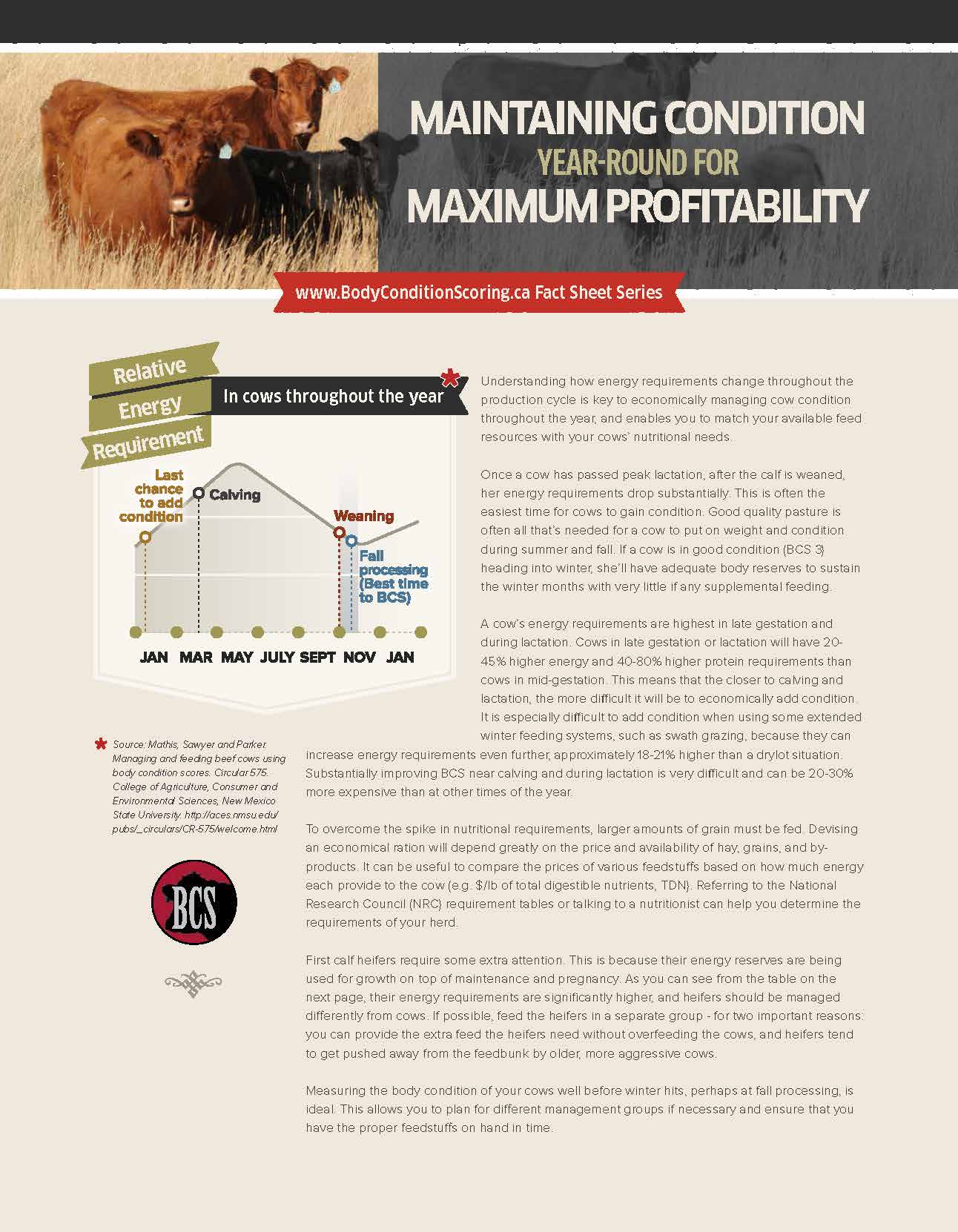 Cattle that are thinner or fatter than the rest of the group should be sorted out and managed separately. Your winter feeding groups might look something like this:
Cattle that are thinner or fatter than the rest of the group should be sorted out and managed separately. Your winter feeding groups might look something like this:
Group 1: Mature cows in good condition
Group 2: Bred Replacement Heifers/2nd Calvers
Group 3: Thin and Old Cows
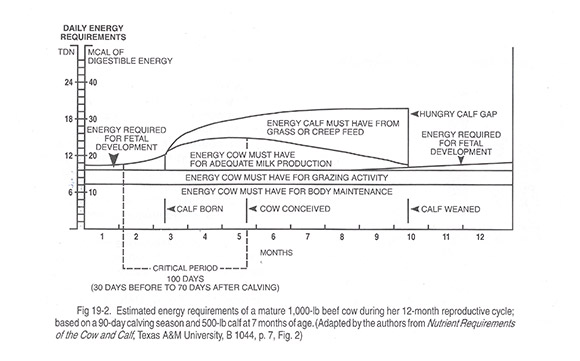
Considerations
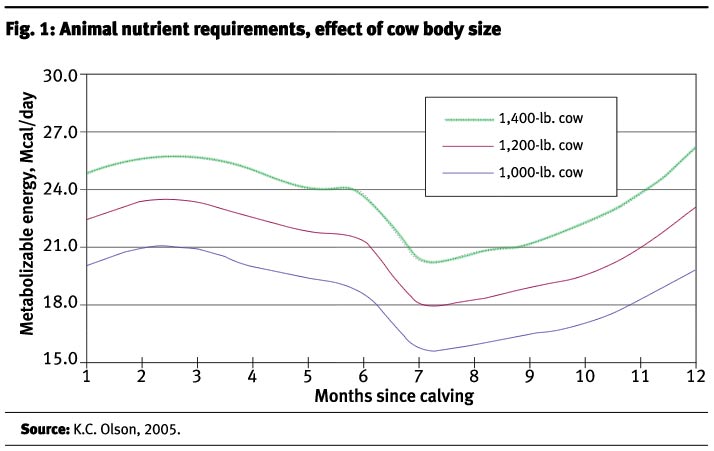
Downloads / Fact Sheets
- References
-
- Beverly, J. R. 1985. Reproduction in beef cattle as related to nutrition and body condition. Kentucky roundup of reproductive efficiency in beef cattle. pp.1-12.
- Hammack S.P., and Gill. R.J. 2009. Texas adapted genetic strategies for beef cattle X: Frame score, frame size and weight. Texas A&M AgriLIFE Extension Publication E-192. | Visit Website
- Herd D.B., and Sprott L.R. 2012. Body Condition, nutrition and reproduction of beef cows. Texas AgriLife Extension: | Visit Website
- Houghton, P.L., R.P. Lemenager, L.A. Horstman, K.S. Hendrix, and G.E. Moss. 1990. Effects of Body Composition, Pre- and Postpartum Energy Level and Early Weaning on Reproductive Performance of Beef Cows and Preweaning Calf Gain. J. Anim. Sci. 68:1438-1446. | Visit Website
- Lalman, D. Nutrient Requirements of Beef Cattle. Oklahoma Cooperative Extension Service Publication E-974. | Visit Website
- Owens F.N., Dubeski P., and Hanson C.F. 1993. Factors that alter the growth and development of ruminants. J Anim Sci. 17: 3138-3150 | Visit Website
- Parsons C.T. Body condition scoring: monitoring the beef cows energy reserves. Oregon State University Beef Cattle Library Publication BEEF001. | Visit Website
- Ringwall, K. 2009. BeefTalk: Four tons of calf is not easy to give up. North Dakota State University Extension Service. | Visit Website
- Siemens M., and VanderVelde K. Body condition, nutrition and reproduction of beef cows: | Visit Website
- Thurlow K. 2014. Body Condition Scores are a great tool for the beef cow herd. Michigan State university. | Visit Website
- Waldner CL, García Guerra A (2013) Cow attributes, herd management, and reproductive history events associated with the risk of nonpregnancy in cow-calf herds in Western Canada. Theriogenology 79(7), 1083–1094. | Visit Website
- Waldner CL (2014) Cow attributes, herd management, and reproductive history events associated with abortion in cow-calf herds from Western Canada. Theriogenology 81, 840–848. | Visit Website
- Waldner CL (2014) Cow attributes, herd management and environmental factors associated with the risk of calf death at or within 1 h of birth and the risk of dystocia in cow–calf herds in Western Canada. Livestock Science 163, 126-139. | Visit Website
- Walker J., and Perry G. Cow Condition and Reproductive performance. South Dakota State university department of animal and range sciences | Visit Website
- Whitman, R. W. 1975. Weight change, body condition and beef-cow reproduction. Ph.D. Dissertation. Colorado State Univ., Fort Collins.
Feedback
Feedback and questions on the content of this page are welcome. Please e-mail us at info@beefresearch.ca.
Expert Review
This content was last reviewed October 2023.
